Forty years ago, I set out with a high school friend to travel around Europe and beyond. This is the second article in a five-part series that will look at my yearlong journey which would eventually determine my life as a photo journalist and adventurer. In this segment we buy a car and travel along the coast of southern Europe until we reach Greece. I made my debut in photography on this trip using an Olympus 35RD rangefinder camera with fixed 40mm f1.7 lens.
Text and Photographs by Norbert Schiller
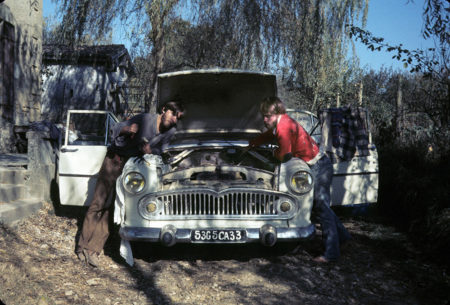
Steve and I fine-tuning the engine of the Simca and replacing the old battery shortly before departing from Chateau Brandeau.
After nearly six weeks of living and working at Chateau Brandeau in the southwest of France, my travel partner Steve and I felt it was time to hit the road and explore other parts of Europe and beyond. One day our high school friends Cathy and Maria (Pilar), who were also spending time at the vineyard, found a car for sale and asked us if we were interested in pitching in to buy it. After negotiating the price down to 600 French Francs (160 U.S Dollars), the four of us became the proud owners of a white 1961 four-door stick shift Simca which we affectionately named Herman. It was one thing to own a car but another to operate it. During the excitement leading up to the big purchase, we forgot about the additional costs of auto insurance, gasoline, oil, and the occasional spare part. Reality finally hit when we stopped at a gas station and realized that it cost 70 Francs to fill the tank.
Being young, and a little reckless, we came up with a plan to offset the cost of gas and the occasional spare parts. Before we left the winery for Spain and Portugal, Steve, Pilar and I got a hose to use as a siphon and an empty gas can and headed out into the night looking for unsuspecting cars parked in the darkness. The first obstacle we came across was that many of the cars had locks on their gas caps because gasoline in Europe was at an all-time high. Our first attempt was quite daring considering we were still amateurs. We were contemplating three cars parked in front of a house and found that the only one with an unlocked gas tank was the one closest to the front door. As we siphoned the tank, we could hear people talking inside. Besides the fear of getting caught, we were also worried about getting a mouthful of gas while sucking on the hose. However, we managed to make a clean getaway and raid two more cars for gas and a new battery to replace our old one. We returned to the winery knowing full well that no matter how far we traveled we would have no problem finding gas within our budget. To this day, I still feel guilty about the unorthodox way we filled up our tank as we traveled on a shoe string across southern Europe.

Cathy and Pilar setting up camp by the side of the road in a forested area in northern Portugal. Steve shopping for vegetables at an outdoor market.
From Bordeaux we headed south to the Spanish border and then drove to the town of Victoria where Cathy had the address of one of her brother’s friends who was a hang glider and skydiver. The house was like a male dorm for glider enthusiasts, and the guys who lived there welcomed us with open arms especially when they realized that neither Steve nor I were romantically involved with our traveling partners.

The four of us outside our cave.
From there we headed to central Spain and Portugal spending the nights sleeping in the car and tent or sneaking into buildings that were still under construction. Once we hit the Portuguese coast we headed south until we came to Sagres, at the southwestern tip of the country. There, we found a brewery, where we loaded up on beer to complement the bottles of wine we had taken from the vineyard, and discovered a virgin beach situated at the foot of steep cliffs to which we immediately gravitated. On our first night, we unrolled our sleeping bags on the sand and succumbed to sleep. In the middle of the night, I was jolted from my deep sleep to find a man hovering over me and talking to me in a strange language. I was so confused that I could not make out where I was or what he was saying. My initial fear gave way to curiosity when he kept pointing to something on the cliffs above. Finally, he insisted that I follow him to a cave high upon the cliffs where he explained, using hand gestures and sound effects, that the tide would soon come in to swallow up the entire beach. It turned out that he was a local fisherman who knew the area well. When we went back down to the beach, we woke up the others and suggested we move up to the cave. The next morning, when we looked down on the beach, we could not locate our tracks from the previous night. I can only imagine our fate if the fisherman hadn’t woken me up that night.

A secluded beach beneath the cliffs at the southern tip of Portugal where we camped. The view of the beach from our cave after the high-tide had erased our tracks from the previous evening.
After a few days of chilling out on the beach we hit the road again in the direction of Sevilla where we had an open invitation to stay with Bulla, another glider pilot and skydiver. On our first day there, Bulla took us out to bars and restaurants where he wined and dined us. For travelers on a tight budget his generosity was a real treat, but again it wasn’t the guys he was trying to impress. The following night, Steve and I went down to the parking lot below Bulla’s apartment and, while we were syphoning gas from a parked car, a police foot patrol spotted us and found us suspicious. When they came over to check out what we were up to, they asked us to put our hands up, frisked us, and then searched the car. When they were done with their search, the patrol escorted us back to the apartment complex to check if we were actually staying there. We had forgotten the key upstairs, but by miracle someone was leaving the building at that very moment and we were able to slip in. As we were leaving the following day, we noticed that the parking lot was adjacent to a police station. They probably thought we were dealing in drugs.
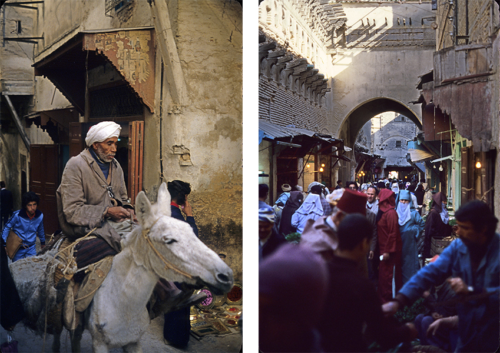
The old Medinas of Tetoun, Meknes and Fez were fascinating. Unfortunately, the relentless harassment by young men wanting to be our guides or take us to their shops put a damper on what could have otherwise been an amazing visit.
Since our time at the vineyard, Steve and I had heard fascinating stories from travelers who had visited Morocco. On 18 November the girls drove us to the Spanish port town of Algeciras from where the two of us hopped on a ferry to Ceuta, the Spanish enclave in North Africa. From Ceuta we crossed on foot to Morocco and then took a short bus ride to Tetouan. Morocco was much more of a cultural shock to me than Steve, who had grown up in India and Western Samoa. The minute we stepped off the bus in Tetouan until we left Morocco a week later, we were continually harassed by young adults and boys who wanted to be our guides and or sell us everything from hashish to sex. I’ll never forget one night, while we were on a six-hour bus ride from Tetouan to Mekness, the bus stopped for a break and when we stepped off to stretch our legs we were suddenly accosted by about a dozen young boys all prostituting themselves. For someone like me who had had a relatively sheltered life, the encounter was a shock.

The Chouara tannery dating back to the 11th century is the largest in Fez’s old city.
Eventually, we were joined by Jim, a fellow traveler deserted by his girlfriend, who could not handle the harassment. After a day of exploring the old part of Mekness the three of us hopped on a third-class train to Fez. Fez was another maze of winding alleyways that seemed to go on forever. It was a feast for the senses walking through the markets that featured everything from spices, to fruits and vegetables, textiles, metalwork ,and carpets. However, it was impossible to walk freely and take photographs as there was always someone tailing us to show us around or take us to their shop. Hoping to escape our stalkers, we would sometimes dart down an alley where we would ultimately get lost and have to ask for directions. Inevitably, we fell back into the trap that we were trying to escape as a new person wanted to be our guide or take us to his shop. It was an exasperating vicious circle. After a week in Morocco we returned to Spain where we were picked up at the ferry by Cathy and Pilar.

Alhambra with its Moorish palace and spectacular gardens was surrounded by gypsy dwellings dug into the hillside.
Our next stop was Grenada in the Sierra Nevada mountains where we visited the Moorish palace and fortress complex of Alhambra with its spectacular arabesques inlayed woodwork, gardens, and fountains. We also walked through the surrounding countryside, where gypsies lived in caves carved into the hillside. As we approached one of the dwellings, a group of gypsy women came running out of their hovel to talk us into paying them in exchange for their fortune telling services. One woman grabbed my hand and said, “you will be rich one day!” I quickly pulled my hand away to check if I still had my watch on my wrist and then made a hasty retreat.

One of the hardships of travel was trying to dig the car out of soft sand. In the end, a tractor had to pull us out. Pilar, Steve and Cathy trying to keep warm over a camping stove in an empty building. To protect ourselves from the cold, we often slept in buildings that were still under construction.
With winter slowly closing in and only a month until Christmas, it was time to make up some ground. Steve and I had tentatively planned to meet two of his sisters who were staying with a family in Northern Greece, but we had all hoped to visit Italy first. As we drove along the Mediterranean coast, we stopped in Valencia, Barcelona, and Montpellier camping alongside the road in the freezing cold until we finally made it to Aix-en-Provence. There, Cathy and Pilar met a young lady who was kind enough to invite us to stay at her place for the night so we could take much needed hot showers, the first since leaving the campground in Algeciras over a week ago.

Luxury yachts, cars, and shops were commonplace in Monte Carlo. The landmark Casino de Monte Carlo.
From Aix-en-Provence we continued to Nice where Cathy was expecting a package with a camera at the American Express office. We all felt so out of place walking around Nice dressed as in our old tattered clothes and worn out shoes compared to the city’s beautiful people in their fashionable clothes. The city itself was all decked out with Christmas lights and decorations. After two days in Nice and still no package, Steve and I decided to drive ahead to Monaco. If we were out of place in Nice, then we were like aliens in Monaco where glitz, money, furs, and luxury shops were the norm. Steve and I must have looked like paupers driving in our banged up and dirty Simca alongside Rolls Royces, Lamborghinis, Ferraris and other luxury cars. Surprisingly, when we were walking around, we caught the attention of a local named Thomas who took us under his wing, invited us to his family house for dinner, and showed us around for the next two days. Thomas even took us to the grand casino where we tried our luck at gambling. Considering the way we were dressed, we were astonished that the security guard let us walk through the door, but then again, we were in good company. In the evenings, we retreated to the hills above Monaco, found a spot in the shadows, and slept in the car.

Milan’s Piazza del Duomo had a majestic cathedral on one end and cheesy illuminated ads on the other.
Cathy and Pillar finally showed up, without the package, and we continued on to Milan. However, the thrill of adventure that had kept us together had started to wear off and when we reached our destination, the girls broke the news that they were continuing their travels by train leaving us with the car. By then, the four of us had been together for a month and the long distances we had covered roughing it by the side of the road, sometimes in freezing temperatures, had provoked tensions within our small group. Even though it was a bit of a shock, the separation was for the best. However, before going our separate ways, we bought standing room tickets to watch two operas back-to-back at La Scala, one of the leading opera houses in the world.
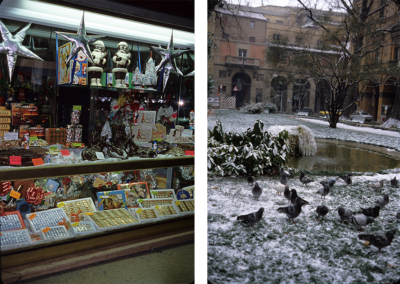
Christmas decorations and colorful chocolates adorn a storefront window display while pigeons huddle in a small square in Bologna’s old city center.
Since we had taken off from France, we had made it a point to stay off the main toll highways sticking to back roads to save money. The one disadvantage was that the journey always took much longer. We followed that same reasoning in Italy, where after parting with the girls Steve and I drove out of Milan toward Firenze, pulling off the side of the road to go to sleep. In the middle of the night I awoke to hear Steve talking with someone through the window. Suddenly, there was a lot of commotion and we were ordered out of the car by a policeman waving a pistol in the air. I managed to put on my pants, but Steve stepped out in his underwear with his sleeping bag wrapped around him. There were two other policemen with machine guns one of which searched the car while we stood in the freezing cold. After questioning us about the wine bottles we still had in the trunk of from our time at the vineyard, they left and let us go back to sleep. I suspect they were looking for drugs.

The road over the Apennine Mountains between Bologna and Firenze was covered with snow. We stayed off the main toll highways to save money.
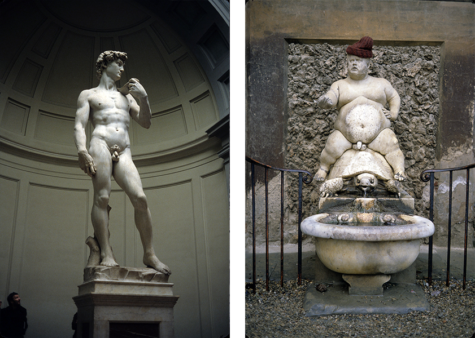
The two most popular men in Firenze were Michelangelo’s sculpture of David and Valerio Cioli’s statue of an obese dwarf riding a tortoise. I lent the dwarf my wool cap.
When we stopped in Bologna, it had just started to snow, and we walked around the old city center admiring the beautiful Christmas decorations in the storefronts. From there we continued on back roads taking a steep and winding path over the Apennine mountains. Halfway up, I realized that our car was not meant to be driven on mountain roads covered in snow. At one point the road became so steep that no matter how hard we tried to go forward, the car just kept sliding back. Finally, we gave up, turned around, pulled off the road and went to sleep. The next morning the road had been cleared, and we were able to drive the rest of the way to Firenze.
I was clearly impressed with Firenze which I described in my diary as “the most beautiful city I have ever seen.” We happened to arrive in the city on a Sunday when all the museums were free, so we visited as many museums as we could, stopping at Michelangelo’s carved marble nude masterpiece of David. From there, we headed to Pisa to see the leaning tower before continuing on to Rome, which I also described as “the most beautiful city I have ever seen.”

Saint Peter’s Square in Vatican City and a ceiling photograph I took of the Sistine Chapel while laying down on the floor.
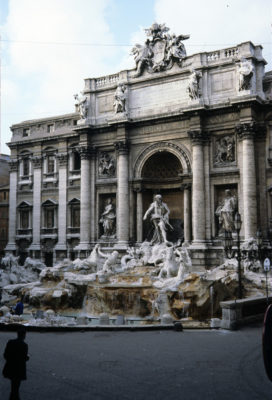
In 1978, very few tourists gathered around Rome’s popular sites such as the Fontana di Trevi. Today, these sites are swarming with visitors and security.
In Rome, a high school friend’s sister Charlotte, who was married to an Italian, invited us to stay at their campsite on the outskirts of the city. However, when I called Charlotte to tell her we had arrived, she insisted we stay at their home near the city center. The first thing that Steve and I did when we got to their house was take a shower, the first in 12 days, our longest stretch without bathing thus far. Rome back then was a far cry from what it is today where long lines and reservations booked well in advance are the norm. When we visited, even popular sites like the Sistine Chapel in Vatican City or the Trevi Fountain were hardly frequented by tourists. I remember laying down on the floor of the Sistine Chapel and taking deep breaths so that I could be still enough to photograph Michelangelo’s ceiling panting “The Creation of Adam.” I don’t think the crowds today would even allow one to stand still long enough to admire the painting, let alone photograph it.
After spending a few days recuperating in Rome at Charlotte’s, we drove across Italy to Ravenna on the Adriatic coast and visited Saint’Apollinare in Classe, the best-preserved Byzantine Basilica in Europe. From there, we continued to Venice where the high tide coincided with a full moon and all of the Piazza San Marco was covered with water. We walked around admiring the beauty of the architecture and the city by night.

Ravenna’s Sant’Apollinare in Classe is the best-preserved Byzantine Basilica in Europe. Saint Mark’s square in Venice is inundated with water during the high-tide.
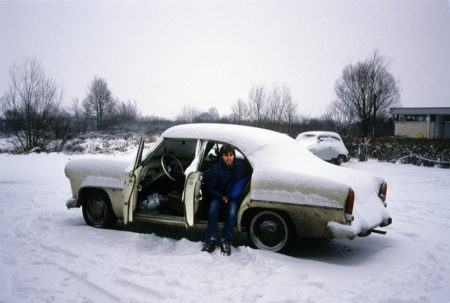
Waking up by the side of the road with a dead car battery in the middle of former Yugoslavia, in freezing cold temperatures.
The strains of traveling were beginning to take a toll on my relationship with Steve. We became easily irritated with one another and would sit for long stretches in silence driving through the winter landscape. It was 18 December and we still had some 1500 kilometers to go before reaching our destination in northern Greece. Crossing Yugoslavia in the dead of winter only exacerbated our feeling of gloom increasing the tension between us. Yugoslavia was blanketed in snow, the temperatures were freezing cold, it was constantly overcast, and we were both tired of sleeping in the car and visiting historic sites. At that point, we just wanted to be in a warm place where we could settle down for a while. We had just left Belgrade, after crossing nearly half of Yugoslavia, and we were in one of those moods where we hadn’t spoken to each other in more than a day when all of a sudden smoke came pouring in through the heating vents. Steve, who was driving, quickly turned off the heater and pulled over to the side of the road, while I jumped out and opened the hood. After the smoke cleared, I noticed that the wires connected to the rear lights had fused and caught fire. Luckily, nothing else was damaged and we were able to proceed. More importantly, the incident thawed the ice between us and for the first time in days we were again on speaking terms. We even stopped in Skopje and walked around the old city admiring some of the Islamic architecture.
When we crossed into Greece, we had to fill in paperwork to bring the car into the country. Since Steve was driving, the customs authorities registered the car in his passport. We didn’t think much of it at the time, but months later, after the car had been sold for scrap metal, Steve was stopped at the border while leaving Greece because he had those stamps in his passport but no car. He was forced to return to the junkyard to retrieve the license plate and other paperwork before he was able to leave the country.

Steve’s sisters Marcia and Julie sit behind me while Maria Papadopoulou and Julie’s friend Kathy are in the front during a Papadopoulou family gathering. Steve and I having a snowball fight with members of the Papadopoulou clan.
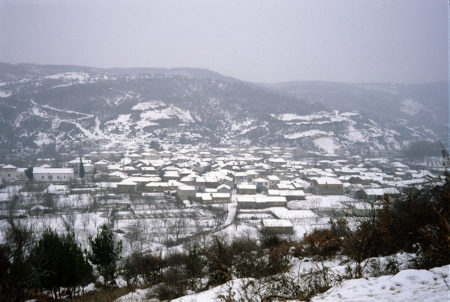
The village of Agra, in Northern Greece, covered in snow.
Two days before Christmas, we finally arrived in northern Greece where we were elated to be surrounded by family and friends. Steve’s two sisters, Marcia and Julie and Julie’s friend, Kathy, were staying at the home of Maria Papadopoulou in the small tucked away village of Agra near Edessa. Life in this tiny Greek village wasn’t easy but it was a far cry from what we had been through since leaving Chateau Brandeau. Now we could relax and digest all that we had been through. In spite of the hospitable environment of our new temporary home, Steve and I were still on shaky terms. Although we still did things together and enjoyed each other’s company, we eventually gravitated to doing our own things to keep the tension between us from spilling over into the household. As a way to keep busy, I spent time with a local goat herder helping him take his goats into the mountains. When I wasn’t with the shepherd, I took long walks by myself or sometimes with Steve’s younger sister Julie in the countryside. The Papadopoulou family owned a considerable amount of land around Agra including the site believed to be the birth place of Alexander the Great’s father, and sometimes I would explore these and other ruins from the 1940s Greco-Italian war on my walks. Steve, on the other hand, was helping out at a restaurant in the village and hanging out with the Papadopoulou clan and their friends perfecting his Greek language skills.

I’m wearing a traditional wool shepherd’s cape over my clothes as protection from the snow and cold while helping lead a herd of goats into the mountains above the village of Agra.

Goats heading for home after a day in the mountains. Shepherds warming newly-born kids by the fire.
When we were in northern Greece, the idea of two single men living in a household full of women to whom they were unrelated did not go over well in this closely knit and ultra conservative community. As a way avert any unnecessary gossip from the villagers, Steve and I were introduced as the Papadopoulos clan’s “American cousins.” Later, when I went on explore other parts of Greece, I continued to introduce myself a relative of the family because it opened doors.
After a month and a half, it was time to set out again, but this time my traveling companion and I took different paths; Steve went off to explore the Greek archipelago, while I set off for Egypt.

What a fun history of your trip Norby. I loved seeing the photos of Agra (as well as all the others). Thanks for sharing 😊